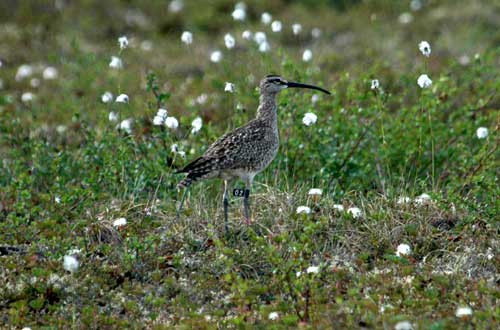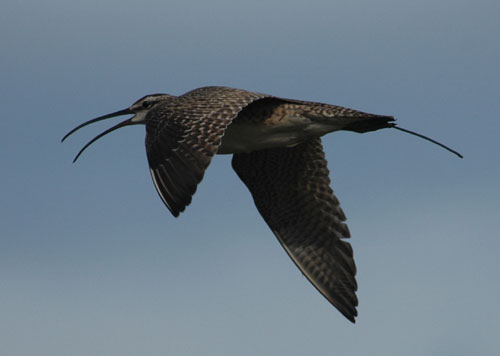 The flight of the Kanuti whimbrel
The flight of the Kanuti whimbrel
By NED ROZELL
July 17, 2009
Friday
Bob Gill had to look twice at his computer the other day. The
two birds he was tracking in Alaska via Google Earth had veered
off the lower right corner of the computer screen.
Those birds, whimbrels that Gill and others had captured and
fitted with a satellite transmitter in the heart of Interior
Alaska about a month before, had migrated out of the state by
mid-July. The birds leapt into the air from western Alaska and
caught tailwinds down south. One bird was winging its way over
the ocean west of San Francisco, and the other was in Mexico.
"Judging by all the flight speeds, the bird flew nonstop
from just south of St. Marys, Alaska, to the Baja Peninsula just
south of Ensenada," said Gill, a biologist with the U.S.
Geological Survey Alaska Science Center in Anchorage.
 A whimbrel at the Kanuti
National Wildlife Refuge on June 14,2009.
A whimbrel at the Kanuti
National Wildlife Refuge on June 14,2009.
Photo by Dan Ruthrauff.
The ptarmigan-size shorebirds with roundish bodies and long,
curved beaks seem to have a knack for taking long flights timed
with weather systems that push them along, Gill said. The bird
that went to Baja was moving as fast as 37 mph.
"These guys have got this stuff hard-wired," Gill said.
"They get ahead of these storm systems and get these great
tailwinds."
The whimbrels Gill and others track are two of 15 birds captured
in Kanuti National Wildlife Refuge and outfitted with satellite
transmitters that a wildlife veterinarian inserted into their
abdomens. The refuge, which
includes most of the Kanuti River drainage between the Dalton
Highway and the Koyukuk River, is about as far from the ocean
as a shorebird can get in Alaska. Most of the Delaware-size refuge
acres are boreal forest, rich in black spruce and boggy lowlands.
Chris Harwood, a Kanuti biologist, spent the spring in a cabin
on the refuge last year and noticed the "qui, qui, qui,
qui" whistle of the whimbrel. After spotting the birds,
he got in touch with Gill, whom he knew studied shorebirds. Gill
is interested in birds such as the bar-tailed godwit; he discovered
a few years ago that some godwits make nonstop flights from Alaska
to New Zealand in fall.
Gill was intrigued with Harwood's whimbrel discovery, and he
and a few other team members flew to Kanuti in early June 2009.
Harwood had located 17 whimbrel nests on a patch of tundra not
far from the refuge cabin, and a team of biologists captured
15 birds and implanted the satellite transmitters in them in
three days in early June.
 Extending from the
tail of the whimbrel is an antenna for a surgically implanted
satellite transmitter.
Extending from the
tail of the whimbrel is an antenna for a surgically implanted
satellite transmitter.
Photo by Dan Ruthrauff.
By July it was time to check the laptop and see where the birds
had headed. The whimbrels had already bred and reared young in
Kanuti, with the father birds lingering to help the fledglings
after the mothers had moved on.
Where the whimbrels went after Kanuti was anyone's guess. Gill
and his team had fitted a whimbrel on the Seward Peninsula with
a transmitter a few years ago, and that one had traveled to the
Salton Sea in California, then on to Columbia. An East Coast
whimbrel made headlines last year by migrating from Virginia
to the North Slope.
The Kanuti whimbrel that is now in Mexico seems to have bred
in Interior Alaska, and, with that mission completed, flew to
the tundra southeast of St. Marys on the Yukon River. There,
it spent 15 days, probably fattening up on berries and insects,
and then set off for a nonstop flight to Baja.
"I would have thought they would have required more time
on the feeding ground," Gill said. "Either they're
putting down fat/fuel faster than we think, or they're more efficient
using that fuel to go migrating distances."
And where will the whimbrels go? Gill said the birds spend their
winters (and late summers, apparently) "anywhere from California
to Tierra del Fuego."
This column is provided
as a public service by the Geophysical Institute,
University of Alaska Fairbanks, in cooperation with the UAF research
community. Ned Rozell is a science writer at the institute.
E-mail your news &
photos to editor@sitnews.us
Publish A Letter in SitNews Read Letters/Opinions
Contact the Editor
SitNews
©2009
Stories In The News
Ketchikan, Alaska
|


